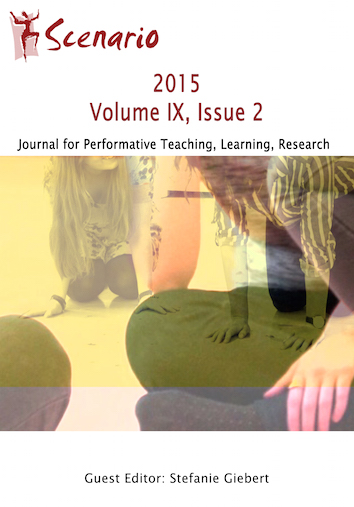Fear and Trembling
DOI:
https://doi.org/10.33178/scenario.9.2.7Abstract
As teachers, we have every reason to take seriously the findings of neuroscience. Learning is after all a brain activity, and those who teach would do well to consider how the brain actually learns. “Neuroscientific research,” writes Michaela Sambanis, “offers powerful insights into the brain mechanisms that underly learning processes. These findings can give a better understanding of how learning happens, how the brain as organ of learning copes with stimuli, how it stores information, how it forms networks, and how competences are developed. In a nutshell, neuroscience can make substantial contributions when it comes to answering the multifaceted question of what helps and what hinders learning” (Sambanis 2016). One of the more powerful neuroscientific findings, though at the same time perhaps one of the least surprising, has to do with the role of emotions in learning: the brain learns more efficiently when cognitive activity is accompanied by “positive” or pleasant emotions (Spitzer 2003). In fact, there is reason to suppose that this is the natural state of affairs, i.e. that learning is in itself pleasurable, and that Nature arranged things for us this way because, with neither sharp teeth and claws nor very much in the way of fur, ...References
Crutchfield, John (2015): Creative writing and performance in EFL teacher training: a preliminary case study. In: Scenario 9/1, 3-34
Dawe, Harry (1984): Teaching: a performing art. In: The Phi Delta Kappan 65/8, 548-552
Eliade, Mircea (1958): Rites and Symbols of Initiation: The Mysteries of Birth and Rebirth (trans. Willard Trask). New York: Harper
Eisner, Elliot (2003): The arts and the creation of mind. In: Language Arts 80/5: Imagination and the Arts, 340-344
Eisner, Elliot (2002): From episteme to phronesis to artistry in the study and improvement of teaching. In: Teaching and Teacher Education 18, 375-385
Franzen, Jonathan (2012): Farther Away. London: Fourth Estate
Hattie, John (2009): Visible Learning: A Synthesis of 800+ Meta-Analyses on Achievement. London: Routledge
Sambanis, Michaela (2016): Drama activities in the foreign language classroom: considerations from a didactic-neuroscientific perspective. In: Schewe, Manfred & Even, Susanne (eds.) (in preparation): Performative Teaching, Learning, Research / Performatives Lehren, Lernen, Forschen. Berlin: Schibri Verlag
Schewe, Manfred (2011): Die Welt auch im fremdsprachlichen Unterricht immer wieder neu verzaubern: Plädoyer für eine performative Lehr- und Lernkultur! In: Küppers, Almut; Schmidt, Torsten & Walter, Maik (eds.): Inszenierungen im Fremdsprachenunterricht: Grundlagen, Formen, Perspektiven. Braunschweig: Diesterweg, 20-31
Spitzer, Manfred (2003): Lernen, Gehirnforschung und die Schule des Lebens. Heidelberg, Berlin: Spektrum Akademischer Verlag
Süleymanova, Ruslana (2011): Abbau der Sprechangst im Unterricht Deutsch als Fremdsprache. Eine empirische Untersuchung im Beispiel der Integrationskurse. Berlin: Verlag Dr. Köster
Tobias, Sigmund (1986): Anxiety and cognitive processing of instruction. In: Schwarzer, Ralf (ed.): Self-Related Cognition in Anxiety and Motivation. New Jersey: Erlbaum
Turner, Victor (1964/1987): Betwixt and between: the liminal period in rites of passage. In: Mahdi, Louse Carus; Foster, Steven & Little, Meredith (eds.): Betwixt and Between: Patterns of Masculine and Feminine Initiation. La Salle: Open Court
van Gennep, Arnold (1909/2004): The Rites of Passage (trans. Monika Vizedom and Gabrielle Caffee). London: Routledge
Published
Issue
Section
License
Copyright (c) 2015 the author(s)

This work is licensed under a Creative Commons Attribution-NonCommercial-NoDerivatives 4.0 International License.







